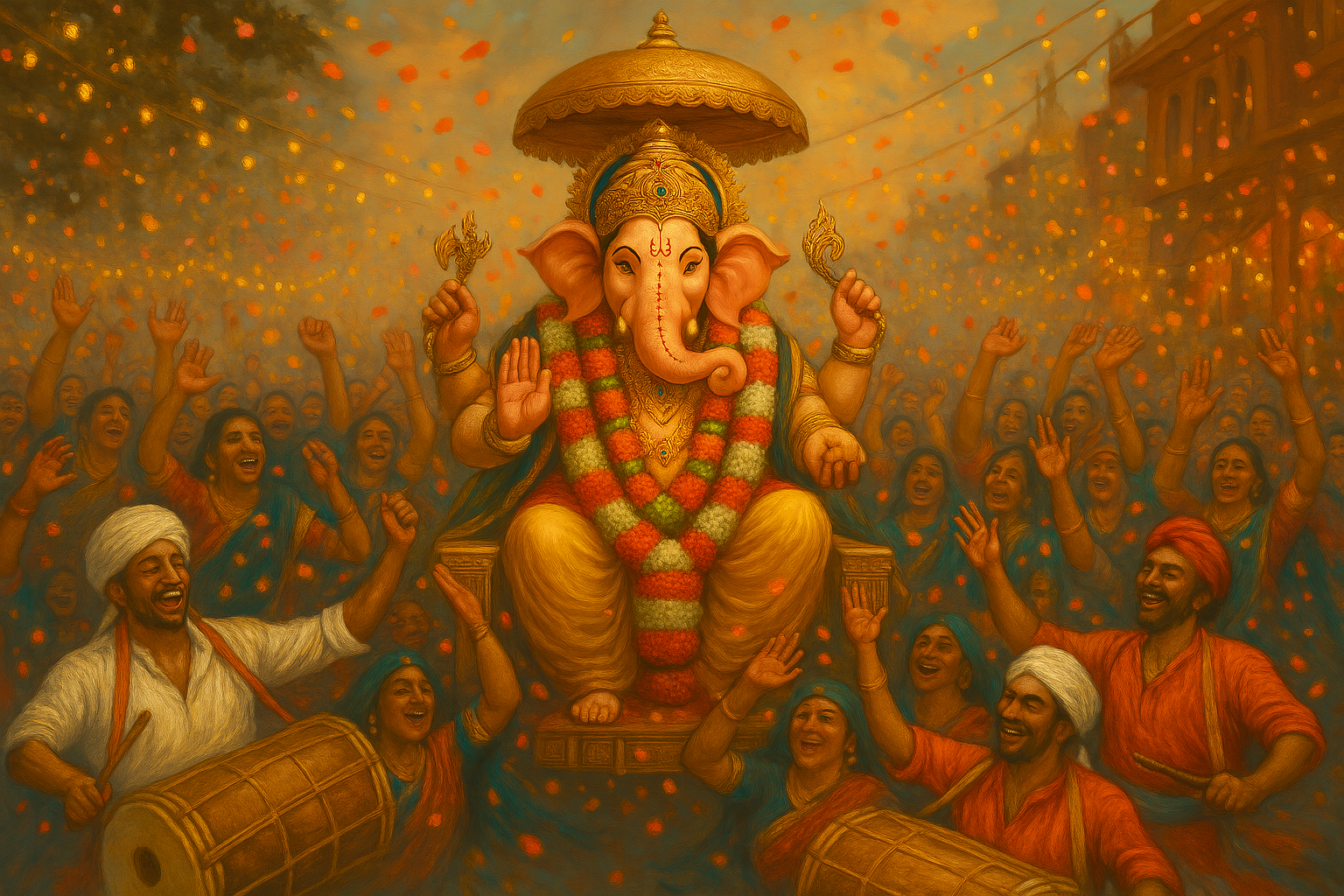
Ganesh Chaturthi – The Birth of Lord Ganesha Explained
Ganesh Chaturthi, also known as Vinayaka Chaturthi, is one of the most beloved Hindu festivals, celebrated with grandeur and devotion across India, especially in Maharashtra, Karnataka, Andhra Pradesh, and Tamil Nadu. But behind the colorful processions, modaks, and chants of "Ganpati Bappa Morya," lies a fascinating mythological story — the birth of Lord Ganesha, the remover of obstacles and the god of wisdom.
Let’s dive into the timeless story that makes Ganesh Chaturthi so meaningful in Sanatan Dharma.
The Divine Origin of Ganesha
The tale begins on Mount Kailash, the celestial abode of Lord Shiva and Goddess Parvati. One day, as Parvati prepared for her sacred bath, she wished to have someone guard her chamber. Since Shiva was away, she decided to create a child out of turmeric paste, which she used for her daily cleansing rituals. With love and divine energy, she shaped a young boy and breathed life into him. This boy was Ganesha — her son, born of her own body.
She instructed Ganesha to stand guard and allow no one to enter. Obedient and loyal, the boy took his task seriously.
The Great Confrontation with Shiva
When Lord Shiva returned to Kailash and attempted to enter the house, he was stopped by the unknown boy. Despite Shiva’s protests and his celestial status, Ganesha refused to let him in. This led to a heated confrontation.
Unable to tolerate the defiance, Shiva, unaware that the boy was Parvati’s creation, ordered his army — the Ganas — to remove the child. But Ganesha, with divine strength, defeated them all. Finally, in a moment of great fury, Shiva severed the boy’s head with his trident.
Parvati’s Grief and the Restoration of Life
When Parvati learned what had happened, her grief turned into uncontrollable rage. She threatened to destroy the entire cosmos with her sorrow and divine wrath. The gods were shaken and pleaded with Shiva to rectify his mistake.
To calm Parvati and restore cosmic balance, Shiva promised to bring the child back to life. He instructed his followers to find the head of the first living being they saw, facing north — a direction considered sacred.
They soon returned with the head of a majestic elephant. Shiva placed the elephant’s head on the lifeless body of the boy and revived him. Thus, Ganesha was reborn, now with the head of an elephant and the blessings of the Trimurti (Brahma, Vishnu, and Shiva).
The Boon – Remover of Obstacles
To honor Ganesha and appease Parvati, the gods bestowed upon him unique boons:
-
He would be known as Vighnaharta – the remover of all obstacles.
-
He would be the first deity to be worshipped before any major undertaking, ceremony, or puja.
-
He would rule over intellect, wisdom, and beginnings — hence the title Buddhi Pradaayaka.
This divine child, born out of love, faith, and transformation, thus became Lord Ganesha, one of the most worshipped deities in Hinduism.
The Symbolism of Lord Ganesha
Lord Ganesha’s form is full of deep spiritual meaning:
-
Elephant head symbolizes wisdom, memory, and foresight.
-
Large ears signify listening more, speaking less.
-
Small eyes represent focus and inner vision.
-
Trunk reflects adaptability and strength.
-
Large stomach denotes the ability to digest both good and bad in life.
-
Mouse (Mushika) as his vehicle symbolizes the ego, which Ganesha controls and rides upon.
These qualities make Ganesha the ideal deity to call upon when beginning a new journey, removing negativity, or seeking clarity and courage.
Ganesh Chaturthi – The Celebration
Ganesh Chaturthi marks the day of Ganesha’s rebirth — the fourth day (Chaturthi) of the bright half of the Bhadrapada month (August–September). It is believed that on this day, Lord Ganesha descends to Earth to bless his devotees.
The festival is celebrated with:
-
Clay idols of Ganesha installed at homes and public pandals.
-
Daily rituals, aartis, and offerings, especially modaks (his favorite sweet).
-
Community prayers, music, and dance, celebrating joy and unity.
-
On the final day, known as Anant Chaturdashi, idols are immersed in water in a ritual called Visarjan, symbolizing Ganesha’s return to Mount Kailash.
People chant “Ganpati Bappa Morya, Pudcha Varshi Lavkar Ya!” (O Lord Ganesha, come again early next year) with devotion and emotional farewells.
Spiritual Lessons from Ganesha’s Birth
The story of Lord Ganesha’s birth teaches us timeless spiritual truths:
-
Obedience and devotion (as Ganesha showed to Parvati) are powerful forms of dharma.
-
Even gods can make mistakes, but humility and willingness to correct them restore harmony.
-
Transformation is possible — destruction can lead to higher rebirth and purpose.
-
Divine wisdom often comes in unexpected forms, reminding us not to judge by appearances.
Conclusion
Ganesh Chaturthi is more than a cultural celebration — it is a spiritual invitation to invoke the divine remover of obstacles within ourselves. Lord Ganesha’s birth, his transformation, and his blessings are reminders of the powerful presence of Shakti (divine energy) and Shiva (cosmic consciousness) in our lives.
As we welcome Ganesha into our homes and hearts, may we also welcome new beginnings, clear our inner paths, and walk forward with wisdom, strength, and joy.
